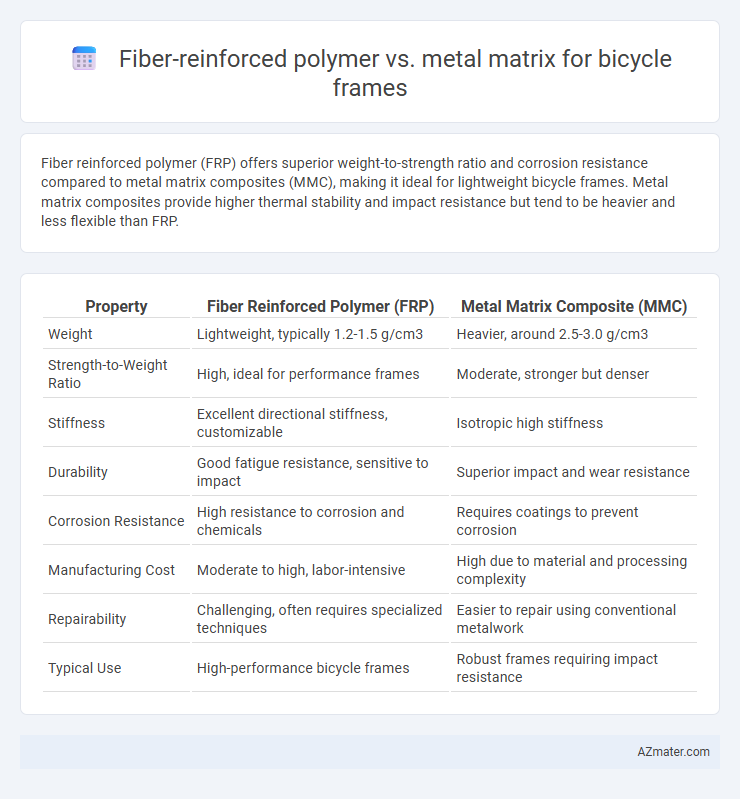Fiber reinforced polymer (FRP) offers superior weight-to-strength ratio and corrosion resistance compared to metal matrix composites (MMC), making it ideal for lightweight bicycle frames. Metal matrix composites provide higher thermal stability and impact resistance but tend to be heavier and less flexible than FRP.
Table of Comparison
| Property | Fiber Reinforced Polymer (FRP) | Metal Matrix Composite (MMC) |
|---|---|---|
| Weight | Lightweight, typically 1.2-1.5 g/cm3 | Heavier, around 2.5-3.0 g/cm3 |
| Strength-to-Weight Ratio | High, ideal for performance frames | Moderate, stronger but denser |
| Stiffness | Excellent directional stiffness, customizable | Isotropic high stiffness |
| Durability | Good fatigue resistance, sensitive to impact | Superior impact and wear resistance |
| Corrosion Resistance | High resistance to corrosion and chemicals | Requires coatings to prevent corrosion |
| Manufacturing Cost | Moderate to high, labor-intensive | High due to material and processing complexity |
| Repairability | Challenging, often requires specialized techniques | Easier to repair using conventional metalwork |
| Typical Use | High-performance bicycle frames | Robust frames requiring impact resistance |
Introduction to Bicycle Frame Materials
Fiber reinforced polymer (FRP) and metal matrix composites (MMC) represent two advanced materials for bicycle frame construction, each offering distinct mechanical properties and weight advantages. FRP, primarily carbon fiber reinforced polymer, provides high strength-to-weight ratio, excellent fatigue resistance, and vibration damping, making it ideal for performance-oriented bicycles. Metal matrix composites combine metals like aluminum or titanium with ceramic reinforcements, enhancing stiffness, thermal stability, and impact resistance while maintaining relatively low weight for demanding cycling conditions.
Overview of Fiber Reinforced Polymers (FRP)
Fiber Reinforced Polymers (FRP) in bicycle frames combine high-strength fibers like carbon or glass with polymer matrices, offering exceptional strength-to-weight ratios and corrosion resistance. These composites provide superior fatigue performance and design flexibility compared to traditional metal matrices, allowing for aerodynamic shapes and vibration damping. FRP frames are increasingly favored in high-performance cycling due to their customizable stiffness and lightweight properties tailored to rider preference and terrain.
Overview of Metal Matrix Composites (MMC)
Metal Matrix Composites (MMC) in bicycle frames offer exceptional strength-to-weight ratios by combining a lightweight metal matrix, such as aluminum or magnesium, with reinforcing fibers or particles. These composites provide superior stiffness and improved resistance to wear, corrosion, and fatigue compared to traditional metal frames. MMC frames enhance overall performance with higher thermal stability and better energy absorption, making them a viable alternative to fiber reinforced polymers in high-performance cycling applications.
Weight Comparison: FRP vs. MMC
Fiber reinforced polymer (FRP) bicycle frames typically weigh significantly less than metal matrix composite (MMC) frames due to the lower density of polymers reinforced with carbon or glass fibers. FRP frames often achieve weight savings of 20-40% compared to MMC frames, enhancing agility and ease of handling for cyclists. Although MMCs offer superior hardness and thermal resistance, their higher density results in increased overall frame weight, making FRP the preferred choice for lightweight performance bicycles.
Strength and Durability Analysis
Fiber reinforced polymer (FRP) bicycle frames offer superior tensile strength and excellent fatigue resistance compared to metal matrix composites (MMC), making them ideal for lightweight and high-performance cycling applications. Metal matrix frames provide enhanced hardness and impact resistance, contributing to better durability under heavy loads and rough terrain conditions. Strength and durability analysis shows that FRPs excel in energy absorption and corrosion resistance, while MMCs outperform in stiffness and resistance to wear, influencing the choice based on specific riding requirements.
Ride Quality and Vibration Damping
Fiber reinforced polymer bicycle frames excel in ride quality due to their superior vibration damping properties, effectively absorbing road shocks and reducing rider fatigue. Metal matrix frames, while offering high strength and stiffness, tend to transmit more vibrations, resulting in a harsher ride experience compared to composite materials. Advanced fiber reinforced polymers like carbon fiber optimize comfort and responsiveness by balancing lightweight construction with enhanced vibration attenuation.
Cost and Manufacturing Considerations
Fiber reinforced polymer (FRP) bicycle frames generally offer lower production costs and simpler manufacturing processes compared to metal matrix composites (MMC), which require high-temperature and high-pressure conditions leading to increased expenses. FRP materials enable mass production through molding techniques like resin transfer molding and filament winding, making them cost-effective for large-scale manufacturing. In contrast, MMCs involve complex fabrication methods such as powder metallurgy or casting with metal reinforcements, resulting in higher costs and limited production scalability.
Environmental Impact and Sustainability
Fiber reinforced polymer (FRP) bicycle frames offer significant environmental benefits due to their lightweight nature, reducing energy consumption during use and transportation, and the potential for recycling advancements in thermoplastic composites. Metal matrix composites (MMC) frames, often made from aluminum or titanium alloys, typically have higher embodied energy from mining and processing, but offer excellent durability and recyclability, contributing to long-term sustainability. Lifecycle assessments show FRP frames generally produce lower carbon emissions, though improvements in MMC recycling technologies continue to enhance their environmental profile.
Maintenance and Longevity
Fiber reinforced polymer (FRP) bicycle frames offer superior corrosion resistance and require minimal maintenance compared to metal matrix frames, which are prone to rust and fatigue over time. Longevity of FRP frames is enhanced by their ability to absorb vibrations and resist environmental degradation, whereas metal matrix frames may experience structural weakening due to repeated stress and oxidation. Regular inspections and preventive care extend the lifespan of both materials, but FRP generally outperforms metal matrix in durability and low upkeep demands.
Choosing the Right Material for Your Riding Style
Fiber reinforced polymer (FRP) frames offer lightweight performance and excellent vibration damping, making them ideal for endurance and road cyclists seeking comfort and speed. Metal matrix composites, often aluminum or titanium-based, provide superior stiffness and impact resistance suitable for aggressive riders who demand durability and precise handling on rough terrains. Selecting between FRP and metal matrix depends on balancing weight, strength, and ride quality according to your specific riding style and terrain preferences.

Infographic: Fiber reinforced polymer vs Metal matrix for Bicycle frame
 azmater.com
azmater.com